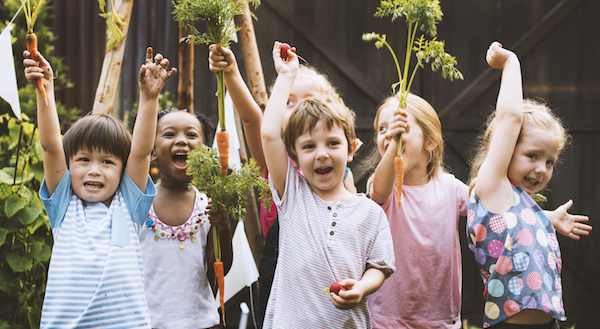Besides sleep, what our children eat is likely one of our primary obsessions. “They won’t eat anything; they only want chicken; they won’t eat vegetables; they eat so much; grandma stuffs them with cookies.” The list goes on and on.
So it’s no wonder that when we hear that one of the ladies in our mom group feeds her child a vegan diet, we’re curious. Who is this wonder woman who can have her child happily eat a diet made up of mostly vegetables? And we also wonder, in the back of our minds, Is it really safe? Or is a vegan diet too restrictive for kids?
“Not at all,” said Sarah Tankersley, who counsels families on dietary plans at no cost as a pediatric dietitian at the Children’s Hospital of Georgia. “If it’s done appropriately, a vegan diet is absolutely safe.”
What exactly is a vegan diet?
It’s simple: A vegan diet consists of plant-based foods. That means no meat, fish or seafood; no eggs, no cheese or other dairy; no honey; and no animal-based ingredients, such as lactose or gelatin.
Most people choose a vegan diet for ethical, environmental or health reasons. Vegans include those who don’t want to use any animal products, whether that’s in food, clothing or for other purposes. They also include those who simply want to be healthier, since a vegan diet can help you lose weight, improve your heart health and have better control over blood sugar.
If not meat, then what?
Unlike most of us, vegans don’t have to worry much about getting enough vitamins and minerals from vegetables and fruit in their diet.
However, the main concern for anyone on a vegan diet—but especially children—is making sure to eat enough protein.
For kids, protein is one of the primary building blocks of growth, essential to maintaining and growing body tissue, such as muscle, bone, blood and body organs. Want to know how much your child needs? Just take his or her weight and divide that by two. So, an 80-pound child needs about 40 grams of protein a day.
Although meat and dairy are admittedly the easiest sources of protein, there are many other alternatives—and delicious—protein sources available, such as:
- Peanut butter (2 tbsp. = 7 grams of protein)
- Broccoli (1/2 cup = 2 grams of protein)
- Soy milk (1 cup = 8 grams of protein)
- Lentils (1 cup = 18 grams of protein)
- Kidney beans (1 cup = 15 grams of protein)
- Meat replacement items, such as vegan burgers (1 patty = about 17-19 grams of protein, depending on the product)
One thing to note: If you’re a vegan mom and are breastfeeding, make sure you’re eating a varied diet with plenty of protein and extra calories so that you can pass those nutrients on to your child. Vegan infant formulas are also available in case you are struggling with milk supply.
Picky—and vegan
As we all know, kids are notoriously picky eaters—and vegan kids are no different. “The issue is when children aren’t eating these alternative protein sources, but instead are filling up on foods that aren’t great protein,” said Tankersley.
Take, for example, the child whose dinner plate consists of noodles, potatoes, and bread—all vegan-friendly foods, but sorely lacking in protein, as well as other vitamins and minerals such as iron.
So what’s a parent to do? As a start, add in a multivitamin. “Most of us should be on a multivitamin, whether we’re vegan or not,” said Tankersley.
Next, a pediatric dietitian can help work with your child to help him or her understand the benefits of adding in other foods. That way, your child is more empowered to make healthy choices. Also, if it’s your older child who has made the decision to become vegan, having that one-on-one with a pediatric dietitian can be very helpful so that your child fully understands the ins and outs of this new diet.
Finally, ensure your entire family is eating foods in a literal rainbow of colors. “Everybody—not just vegans—can get stuck in that rut of eating the same foods over and over again,” said Tankersley. “But if you’re doing that, you’re not necessarily getting a good intake of all the vital nutrients you need.”
So blitz up a fruit and veggie smoothie with some different ingredients; try a fruit or veggie you’ve never prepared before (fava beans, anyone?); or take advantage of technology like the Instant Pot to help you prepare foods in a new way. “Google and Pinterest are also great sources for recipes, as well as the website of the Academy for Nutrition and Dietetics (www.eatright.org),” said Tankersley.
Check-ups matter
If you’re raising your child vegan, your annual visit to the pediatrician is even more important. You’ll want to ask about your child’s growth and make sure it’s on track. Your pediatrician can also check vitamin D and iron levels to make sure those are where they need to be.
But while families who choose to be vegan do need to focus in on a few areas, it’s really no different from what each of us does as a parent and human being every day. “It all comes down to eating a varied diet and ensuring we’re getting the protein, vitamins and minerals we need so that we can be active and healthy,” said Tankersley.
Children’s Hospital of Georgia is the only hospital in the area completely dedicated to the care and well-being of children. To find out more visit augustahealth.org/kids or call 706-721-KIDS (5437) to make an appointment for your child today.




